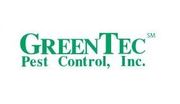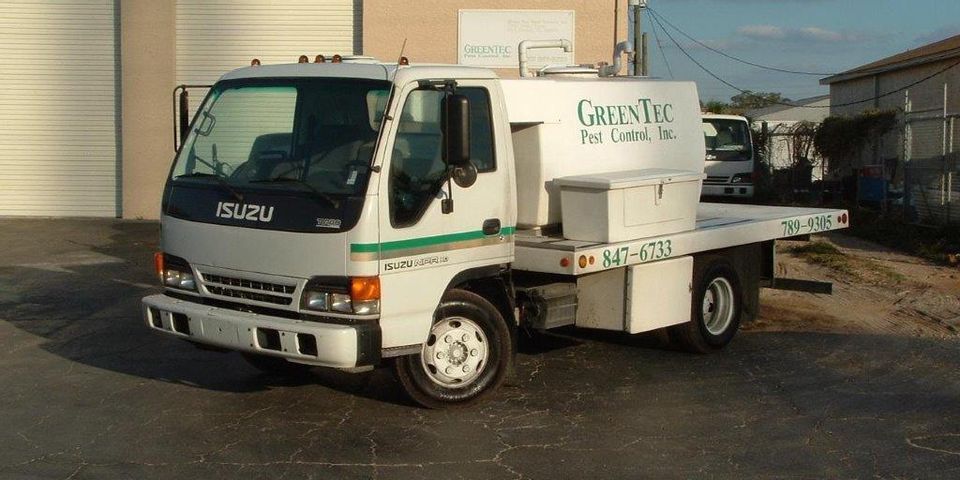
The warm seasons marks the beginning of termites swarms for homeowners in the United States. Florida’s hot and humid climate is ideal for several species of termites. In Florida, populations of termites tend to increase southward along the peninsula and concentrate in older buildings near the coast, but infestations can occur anywhere. In addition, our homes are at risk much earlier in the year than in other regions. Drywood termites live in colonies with different castes and nest entirely within the wood structures they feed on.
Description and Identification
As with all termites, drywood termites are social insects. They live entirely within the wood members they infest and obtain water adsorbed onto wood fibers and by metabolic processes. Drywood termites are generally larger and more cylindrical in body form. Because of their gallery systems are limited to and usually extend only a few meters within their home wood, drywood termites have proportionally shorter legs and move more slowly. Drywood termite colonies are composed of three primary castes. The termites excavate wood to feed themselves and the other caste members in the colony. Eggs and larvae (first few instars) are usually near galleries in habited by the king and queen. All termite species are difficult to distinguish by immature or worker stages or by the wingless king or queen, therefore, soldiers or alates are best be used for species indentification. Soldiers are present in colonies year round, while alates are formed a month before swarming season.
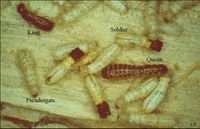
Drywood termites have two wings that are about equal in size and shape and have three or four darkened and enlarged veins in the leading margin of each wing. Termites are weak fliers and flights are slow and drifting, and wings are often shed within minutes of landing. The bodies of drywood termites are medium brown and are about 0.4 inches (11 mm) in length with wings.
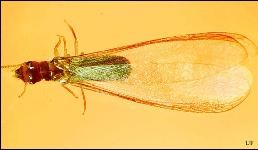
Each year, a proportion of termites in mature colonies molts into alates that leave the colony during a series of dispersal flights over a period of serveal weeks. This is the only time when colony members leave the confines of their excavated wood galleries and is often the first sign of an infestation. Termites fly between dusk and dawn from April through June and are attracted to lights. Occasional small flights in the fall have also been recorded. After a brief flight, the alates quickly shed their wings and segregate into male/female pairs. The male follows the female in tandem as they inspect wood surfaces for defects such as cracks, crevices, knots, or nail holes for chamber excavation.
Damage
Colonies of all drywood termite species infest sound, solid hardwoods, and softwoods, including all common building lumbers used in structural forming. Numerous colonies may inhabit a single structure and more apt than the other species to infest smaller articles of furniture such as headboards, cabinets, and pictures frames. Because drywood termites seek protection from external from external predation, galleries are concealed beneath the wood surface. Sounding with a hard implement can locate hollowed-out wood. A very thin wood surface in late stages of attack may have a blistered appearance. External signs of infestations, however, most often consist of fecal pellets extruded from 0.004 to 0.08 inch (1 to 2 mm) diameter “kick-out” holes. Pellets will accumulate in piles directly beneath holes. Pile diameter is proportional to the height from which pellets fall. Drywood termite fecal pellets, with six longitudinal surfaces capped with one rounded and one more tapered end, are uniquely shaped compared to all other wood-infesting insects. Pellets vary in color from cream to red to black and are expelled periodically from different kick-out holes communicating with the gallery system. Pellets do not change in shape or color over time and their color is often unrelated to the wood from which they were expelled. Swarming alates, wings, and ejected fecal pellets are a sanitary nuisance, and pellets may present a slipping hazard on smooth floors.
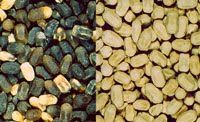




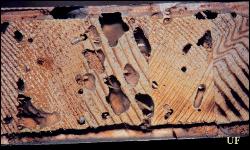
Drywood termites are an almost ubiquitous part of older wooden structures in regions where they commonly occur. Structures only 5 to 10 years old may harbor infestations requiring treatment. Drywood termite control costs in the United States are estimated to exceed $300 million annually with greatest losses occurring in Florida
Management
Preventative methods are aimed at excluding alates from structures, controlling reproductives, or preventing their nuptial chamber construction. Exclusion consist. of “tight” building practices, caulking, and small mesh attic screening, but complete blockage of alate entry points is difficult. Because drywood termites are hidden inside the wood they infest, it may be difficult to immediately verify the success of a given treatment. A swarm within a few years of treatment suggests either that the treatment was unsuccessful, infested wood was brought in, or a hidden, untreated, infestation was present and must now be treated. Accumulation of pellets, especially in a cone-shaped pattern, is also a sign of active drywood termites. All pellets should be removed after a treatment to insure that colony activity has ceased. Pellets may continue to trickle from wood after successful control if the wood member is periodically subjected to vibrations or jarring such as a door or door frame.
Remember the signs of an infestation:
- Winged insects emerging in evenings and night attracted to lights or TV.
- Discarded wings accumulating around window sills or in spider webs
- Wooden pellets (much smaller than rice grains) accumulating on floors or under furniture. These pellets are cream to reddish brown or black. The color of the pellets is not related to the color of the wood. The pellets are about 1-2 mm long and distinctively six-sided, making them easily distinguishable from other wood-destroying organisms. Pellets usually fall into piles as the termites push them out of the infested wood
- A sign of advanced infestation is surface blisters. These termites sometimes tunnel close to the surface giving the wood a blistered appearance. Infestations may be detected by tapping the wood every few inches with the handle of a screwdriver. Damaged wood sounds hollow – a papery rustling sound indicates tunnels just beneath the surface.
- Swarming (mating flights) often occur in the evening hours
- Late Spring and Summer months are the peak season for winged drywood termite swarming flights.
- Coastal and southern areas of the state are more likely to have an infestation of drywood termites occur
- Even though colonies are slow to develop if left unchecked for extended periods of time substantial damage can occur
An inspection is an important step both in the prevention of damaging populations of drywood termites and in the elimination of existing infestations. Before control can be properly applied, a thorough inspection must be performed, both to identify the extent of the infestation and allow proper planning of the control operation. If you suspect an infestation of drywood termites please call us at GreenTec Pest Control (727) 847-6733.
About the Business
Have a question? Ask the experts!
Send your question

